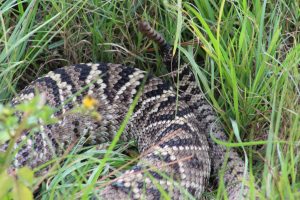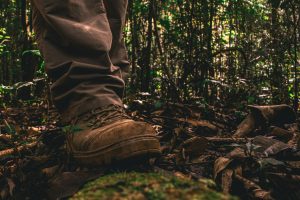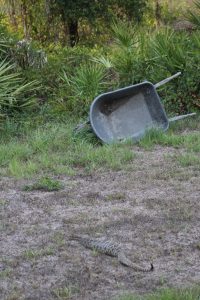
Snakes are an integral part of Florida’s healthy, well-functioning ecosystems. They help balance populations of rodents and other small mammals, reptiles, insects, and amphibians. Some snakes even eat other snakes, as well as some of our non-native and invasive animal species too!
Whether venomous or non-venomous, these serpents have also come to be the source of intense fear and aversion. With increased awareness, greater education, and an understanding of snake safety precautions, some of that fear can be replaced with knowledge, empowerment, and respect for these unique animals.
In part two of this two-part blog series, learn what to do when you encounter a venomous snake, and best practices for staying safe and preventing negative interactions with both venomous and non-venomous snake species. Head over to part one of this series to learn how to identify Florida’s venomous snake species.
Learn about common non-venomous snake species found in Sarasota County, as well as a variety of other wildlife by reading other blogs in our Wild Sarasota blog series, or explore all the topics on our Florida Wildlife webpage.
Snake Encounters

If you do encounter a venomous snake, it is best to stay calm, keep your eyes on it, and steadily back away from the snake. Snakes are generally not aggressive and will not attack unless they feel disturbed, threatened, or cornered. Biting or attacking makes them vulnerable and puts them at risk of mortal injury, as they are soft bodied, do not have claws, and are prey for several species of other wildlife. They would prefer to stay concealed or escape. When hiking, do not step over or walk past venomous snakes- allow them plenty of space and a clear path to escape or continue along their way. If you must continue walking, find a safe route that places as much distance between you and the snake as possible.
When you attempt to kill, catch, pick up, handle, or trap a snake, you are placing yourself at a significantly greater risk of being bitten! Snakes are incredibly strong and can have over 2 times as many muscles in their body as we do. Some snakes, like the Eastern diamondback rattlesnake, can even strike 2/3 the length of its body (Florida Museum, n.d.). These combined factors mean that a snake could bite you much faster than you think when you attempt to handle or kill it. Additionally, snakes are important for Florida’s ecosystems, and are often cruelly killed. Many harmless, non-venomous snakes lose their lives as a result of improper identification.
What to Do if Bitten?

If you are bitten by a snake, it is safest to treat all snake bites as a venomous snake bite, and seek immediate medical attention. Antivenom (antivenin) is the best treatment for venomous snake bites, and medical professionals and establishments have the equipment necessary to support snake bite victims’ vital functions.
Put distance between yourself and the snake. Do not approach it, touch it, or pick it up, but try to remember the species’ coloration and patterning. Staying calm and as still as possible, with the bitten extremity below the heart will help keep the venom from circulating around the body faster. Remove any jewelry or clothing that may restrict blood flow in a swollen extremity.
DO NOT:
- Apply a tourniquet
- Apply ice to the wound
- Cut the wound open
- Attempt to suck out the venom
- Ingest medications, stimulants, or alcohol
- Panic, walk fast, run, or drive frantically
The speed and severity with which symptoms develop can vary widely based on type and amount of venom injected, sometimes occurring even days after the initial bite. Never delay seeking emergency medical care, even if you do not initially feel any symptoms.
Safety and Prevention

Worried about encountering a venomous snake? Here are a few guidelines for staying safe and reducing your risk of having a negative interaction with a snake:
- Never approach, corner, or attempt to catch, trap, kill, agitate, or pick up a wild snake- even bites from non-venomous species can be unpleasant and cause infection or allergic reactions.
- Educate yourself and your children about the venomous and non-venomous snake species in your area, and how to behave around snakes.
- When hiking, walking, or playing outdoors:
- Wear long pants and shoes/boots that cover your feet and ankles.
- Stay on trails/avoid walking through areas with tall grass and brush that prevents you from seeing what is on the ground.
- Do not reach your hands or feet into cracks and crevices or on top of rocks, tree branches, and other areas where you cannot see clearly/fully.
- Step on top of logs rather than over.
- Use a trekking pole or walking stick to navigate through tall grass/brush.
- In and around the home:
- Keep your yard clear of wood and debris piles, abandoned vehicles, overturned wheelbarrows, tools, etc.
- Seal entry and exit holes/structural damage.
- Reduce sources of food, shelter, and water for rodents.
- Avoid crawlspaces, beneath porches, other dark, sheltered, cluttered areas.
- Exercise caution when gardening, doing yard work, or other maintenance and outdoor tasks around a home or property.
Learn More
- Dive deeper into Florida’s venomous snake species and their lookalikes, and view more images with this full-length webinar
- Read part one of this series to learn how to identify Florida’s venomous snake species
- UF/IFAS EDIS Document: Recognizing Florida’s Venomous Snakes
- Florida Museum: Identify a Florida Snake
- UF Department of Wildlife Ecology and Conservation, Johnson Lab: Florida’s Snakes
Learn about common non-venomous snakes found in Sarasota.
Read all our Wild Sarasota blogs HERE.
Sources
- Petty, M. (2019, September 4). How Not to Identify a Venomous Snake. Medium. https://medium.com/natural-world
- Florida Museum. (n.d.). Florida Snake ID Guide- Eastern Diamond-backed Rattlesnake. Florida Museum. https://www.floridamuseum.ufl.edu/florida-snake-id/snake/eastern-diamond-backed-rattlesnake/
 0
0

